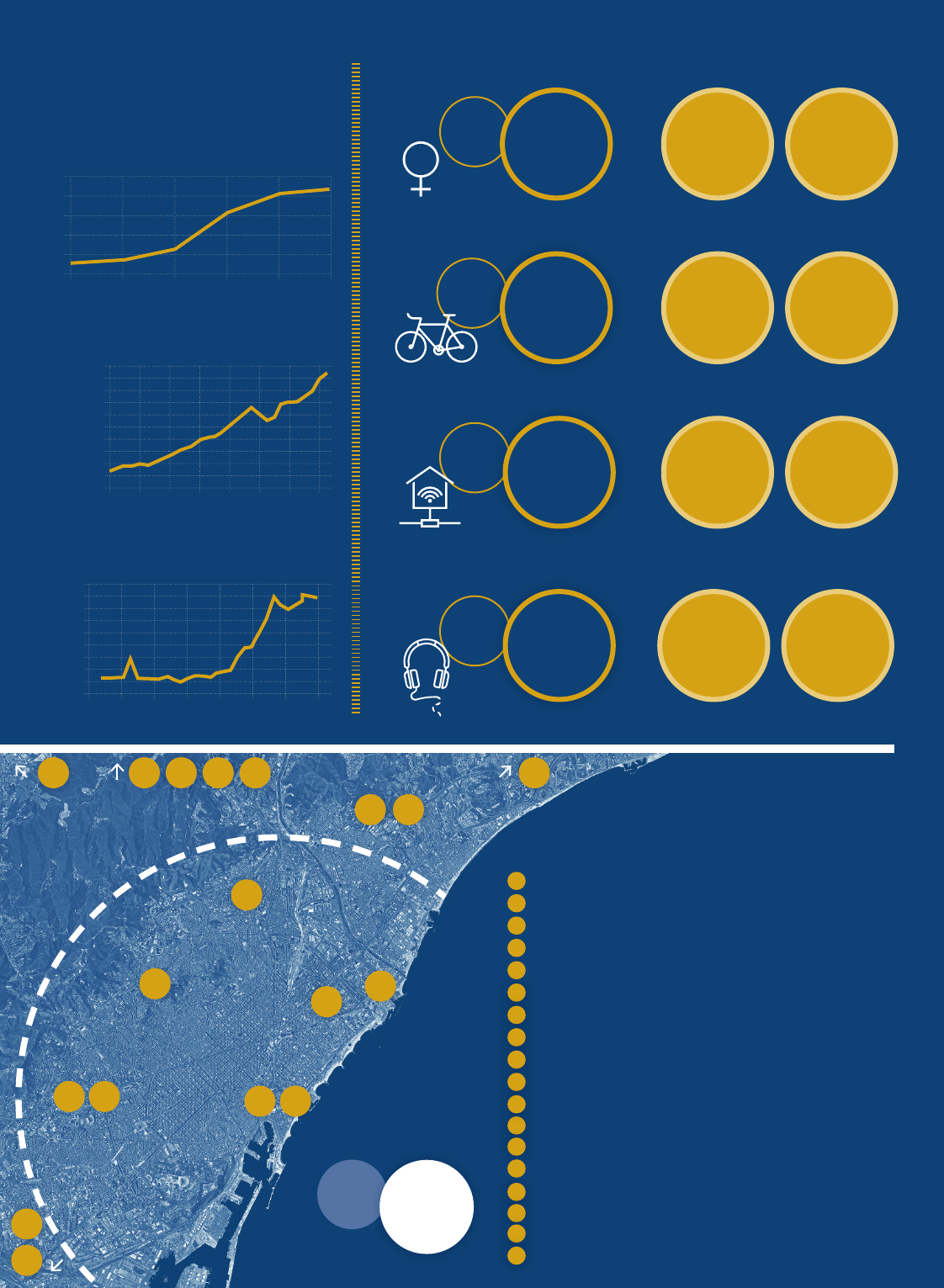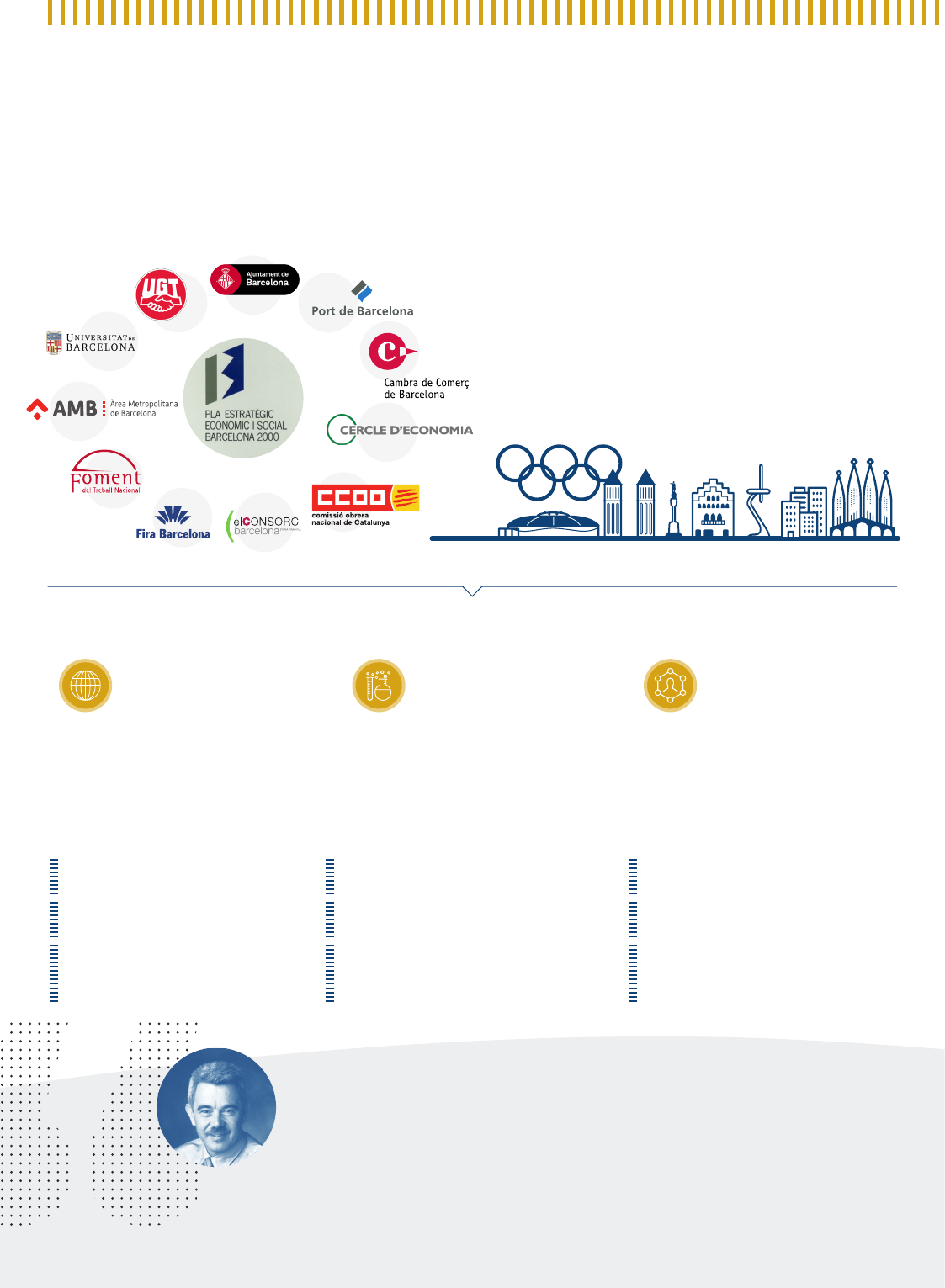
Barcelona
Metropolitan
Strategic
Plan
designing
the Barcelona
of the future
YEARS

history
ADA COLAU
Mayor of Barcelona,
president of the AMB
and president of the PEMB
Opening of the Vallvidrera tunnels
Opening of the first permanent cycling lane in Barcelona
Barcelona Olympic Games and opening of the ring roads
La Diagonal reaches the sea. New Rambla del Raval
Integrated fare system in the Barcelona area
The tram returns to Barcelona + Universal Forum of Cultures
Arrival of the high-speed train (AVE)
Smart City Expo
Opening of the L9 Sud
Mobile World Congress is held in the fairgrounds
at Gran Vía de L’Hospitalet
The new bus network begun in 2012 is completed and launched
Pressure on infrastructure: major blackout,
chaos on local train (Cercanías) and episode of drought
Opening of the airport’s new terminal (current T1)
and the El Prat desalination plant
Attack on the Rambla in Barcelona
First Quincena Metropolitana de Danza urban dance event
Fall of the Berlin Wall
Google is created
Terrorist attack in the United States
Facebook is created
Beginning of the world financial crisis
Arab Spring and nuclear accident at Fukushima
Brexit referendum
Mass protests around the world
over the invasion of Iraq
IN BARCELONA
IN THE WORLD
1988
1989
1990
1991
1992
1994
1998
1999
2000
2001
2003
2004
2007
2008
2009
2010
2011
2013
2016
2017
2018
2020
FIRST ECONOMIC AND SOCIAL STRATEGIC
PLAN FOR BARCELONA
SECOND ECONOMIC AND SOCIAL STRATEGIC
PLAN FOR BARCELONA
THIRD ECONOMIC AND SOCIAL STRATEGIC
PLAN FOR BARCELONA
VISION 2020 STRATEGIC PLAN
METROPOLITAN
STRATEGIC PLAN
NEW STRATEGIC PLAN 2030
CREATION OF THE BARCELONA STRATEGIC PLAN 2000
REFOUNDATION:
BARCELONA METROPOLITAN STRATEGIC PLAN ASSOCIATION
THE METROPOLITAN AREA BECOMES PRESIDENT
OF THE PEMB
NEW IMPETUS FOR THE PEMB
(
30 YEARS
)
FORMAL CONSTITUTION OF THE
BARCELONA STRATEGIC PLAN 2000
SOCIAL AND ECONOMIC PROGRESS BASED
ON INNOVATION AND SUSTAINABILITY TO REDUCE
INEQUALITIES AND URBAN SEGREGATION
2030
“Metropolitan cities and areas have a major responsibility to
provide an effective response to the new global challenges that
states have been unable to solve on their own. (...) This is why
creating spaces for thinking and planning the future of cities
also means thinking and planning the future of the planet”

ATTRACTIVENESS
3
1990
18th-most
attractive
European
city
4th-most
attractive
European
city
2010
URBAN GREENERY
1
6,240,856
m
2
11,306,115
m
2
1988 2016
VISITORS TO THE SAGRADA FAMILIA
1
500,000 4,527,427
1988 2017
UNIVERSITY AND VOCATIONAL
STUDENTS
1
124,303 132,162
1988 2017
0 of 34
1988
CYCLING LANES
1
0 km
1988
126.2 km
2016
HOMES WITH INTERNET
1
0%
1988
85.4%
2017
METROPOLITAN FEMALE MAYORS
2
MUNICIPALITIES
19 of 36
2017
the changes
8
5
4
1617
12
15
18
1
13
142
3
6
7
9
10
11
MAP OF THE SCIENCE
AND TECHNOLOGY PARKS
FOREIGN-BORN POPULATION IN THE CITY
OF BARCELONA
1
1991
25 %
20 %
15 %
10 %
5 %
0 %
1996 2000 2005 2010 2015
EVOLUTION OF AIRPORT TRAFFIC AT THE
EL PRAT AIRPORT
1
1988
0
5,000,000
10,000,000
15,000,000
20,000,000
25,000,000
30,000,000
35,000,000
40,000,000
45,000,000
50,000,000
1992 1996 2000 2004 2008 2012 2016
PEOPLE ATTENDING SÒNAR
AND PRIMAVERA SOUND
1
0
1988
2017
123,980
208,400
PRIMAVERA SOUND
SÒNAR
PARTICIPANTS IN THE BARCELONA MARATHON
2
1985
0
2,000
4,000
6,000
8,000
10,000
12,000
14,000
16,000
18,000
1990 1995 2000 2005 2010 2015 2020
0
1988
18
2018
1
Statistical yearbook of the city of Barcelona -
2
2Own creation -
3
Olympic mosaic. Multidisciplinary research and dissemination of the Olympic studies CEO-UAB, 20 years. Barcelona City Council. Ferran Brunet.
Barcelona Science Park – Les Corts
Barcelona Biomedical Research Park– Sant Martí
Barcelona Synchrotron Park – Cerdanyola del Vallès
UAB Research Park – Bellaterra, Cerdanyola del Vallès
UPC Research Park – Les Corts
B_Tech – Sant Adrià de Besòs
ESADECREAPOLIS – Sant Cugat del Vallès
Tecnocampus – Mataró
La Salle Technova – Sarrià Sant Gervasi
Parc Tecnològic del Vallès – Cerdanyola del Vallès
Mediterranean Technology Park. PMT – Castelldefels
Orbital 40. Science and Technology Park of Terrassa
Barcelona Activa – Technology Park – Nou Barris
UPF Research Park – Sant Martí
Biopol’H Consortium – L’Hospitalet
Can Ruti – Badalona
Food and Nutrition Torribera Campus – Santa Coloma de Gramenet
22@ technology district
1
2
3
4
5
6
7
8
9
10
12
13
14
15
16
17
18
11

1988
The Strategic Plan was created in 1988
as a way for the major players in society
to agree on what Barcelona should look
like in 2000.
This exercise was proposed shortly after Barcelona
was nominated the host city for the 1992 Olympic
Games, after Spain joined the European Economic
Community and following the dissolution of the
Metropolitan Corporation of Barcelona.
Barcelona faced a series of challenges ahead of the year 2000
The projects of the different city strategic plans (1990, 1994 and 1999)
and metropolis strategic plans (2003 and 2010) focused on:
To be a competitive city
on an international scale,
becoming the axis of the
northwestern Mediterranean
macro-region.
To shift from an industrial
city to a metropolis
whose economic activity
centres around advanced
services.
Increase social cohesion,
preventing the risk of
social segregation.
Challenges
“My grandfather was born in the La Ribera neighbourhood and in a
generation he moved beyond the wall, to Calle Trafalgar, Eixample and
Sant Gervasi. If our grandparents took that gigantic leap, I am convinced
that our generation will take the metropolitan leap”
Pasqual Maragall (1982), Per una Barcelona Olímpica i Metropolitana. Barcelona:
Servicio de Publicaciones y Documentación Municipal, 15.
PASQUAL
MARAGALL
Mayor of Barcelona (1982-1997)
and president of the General Council of the PEMB (1988-1997)
at the
starting point
A heavy investment in
infrastructure (new airport and
trade fair, expansion of the port,
new cultural infrastructure, the
ring roads, the AVE and more).
A commitment to the service
sectors based on the knowledge
economy, giving a powerful boost
to research activity and to advanced
services for productive activity.
Improvement of the
neighbourhoods of the metropolis
and public, making it more
accessible to all.

2018
To combat the growing inequalities in access to housing or a job,
and ensure a quality urban environment and equal opportunities
for all throughout the region.
To join other metropolises around the world in fighting against
climate change, absorbing the impact of digitalisation
and successfully integrating migrants and refugees.
To articulate more effective metropolitan policies, from spatial
planning to economic and social development, environmental
management and the promotion of research, education and culture.
To have the tools of governance that strengthen democracy,
public-private community collaboration and civic participation
at all local scales (neighbourhood, municipality and metropolis).
What are the current challenges?
“The Barcelona Metropolitan Strategic Plan has allowed us to expand a
creative territorial vision and learn how to incorporate the dynamic and
intelligent life of the set of initiatives and social realities that make up
the metropolitan area”
ANTONIO
BALMÓN
Mayor of Cornellà de Llobregat and executive vice president of the AMB
1950: 30%
2014: 54%
2050: 66%
5
1
OCDE -
2
OIT -
3
ESPAS -
4
ESPAS -
5
NN.UU -
6
Wagner et all -
7
ESPAS -
8
UN -
9
Roland Berger Trend Compendium 2030 -
10
McKinsey Global Institute: Jobs lost, jobs gained: workforce transitions in a time of automation.
2016: 31
2030: 41
6
GDP forecast growth
= (2016-2030)
Worldwide growth
of the middle class
Number de megacities
(+10 M) worldwide
2012
EU: 23.1%
China: 4.5%
USA: 21.9%
2030
EU: 15.5%
China: 24.9%
USA: 14.7%
3
Territorial
reorganisation
of world trade flows
2009: 1.8 B
2030: 5 B
4
Need to create
470 M jobs in the world by 2030
2
SLOWDOWN
IN ECONOMIC
GROWTH
CHANGES IN ECONOMIC
GLOBALISATION
PATTERNS
URBANISATION
PROCESS
Worldwide
urban population
1.9% annual (euro zone)
3.5% (world)
1
new forms,
new times,
new generations,
greater diversity
GLOBAL TRENDS:
Migrations
34 M people from the least developed to the most
developed countries
2015 to 2030: 13 M towards Europe
9
Shortage of water
and crops affecting
1.4 M people
2 ºC by 2030
7
400 M workers will have been replaced by robots
and between 75 and 375 M workers will have
changed job category by 2030
10
Predicted 50% increase and creation of between
20 and 50 M jobs
Global ageing
55% increase in population over 60 years old between
2015-2030: 61.1% increase in population over 80 years old
8
Estimated job destruction worldwide (2016-2030)
Global expenditure on technology (2015-2030)
CLIMATE CHANGE
AND USE
OF RESOURCES
AGEING OF THE
POPULATION AND NEW
MIGRATION MOVEMENTS
INDUSTRIAL
AND TECHNOLOGICAL
REVOLUTION
Expected rise
in temperature
Use of resources

2030
The PEMB is setting out on a new process of shared reflection
to integrate the proposals coming from their members and
different public, private and civic organisations on the future
of the metropolis to create a strategic plan for metropolitan
Barcelona with a view to 2030.
A central line of this plan will be the promotion of social and economic progress based
on innovation and sustainability as a mechanism for reducing inequalities and spatial
segregation in the metropolitan area.
To develop this new plan, we propose working based on three major pillars:
“With its overall view of the metropolitan phenomenon, the PEMB is a
space to deal with complexity from cross-cutting perspectives, a space for
collaboration between organisations representing very diverse interests and
a space to address strategic projects that integrate the points of view and
capacities of public, private and civic organisations”
JANET
SANZ
Fourth deputy mayor of Barcelona, vice president of Strategic Planning
for the AMB and president of the Executive Committee of the PEMB
future vision
To establish a metropolis as an urban
laboratory that uses innovation and
creativity to generate prosperity and new
solutions to urban challenges, we must
take advantage of the possibility of building
the new strategic plan alongside the new
metropolitan urban master plan to outline
a metropolitan Barcelona fully prepared to
welcome and develop mobility, economic
activity and research and knowledge in the
21st century.
A PROSPEROUS
METROPOLIS
Connected and networked, promoting
smart, sustainable and inclusive progress,
focused on improving the quality of life and
generating opportunities for all. Education
is the best way to achieve this and will be
accompanied by the digital revolution, the
transformation of traditional economic
sectors, the promotion of a more diverse
and varied economy and metropolitan
governance with the tools to achieve
greater equity.
A COHESIVE
METROPOLIS
Having the tools and alternatives to satisfy
basic needs for everyone, everywhere and
at all times is about ensuring clean air;
sufficient quality water; food that is good,
healthy and produced in fair conditions;
sustainable energy; and affordable
housing. These are the elements to move
towards a healthier metropolis.
A RESILIENT
METROPOLIS

Shared
metropolitan
commitment
SDGs
Sustainable
Development
Goals
Just like 30 years ago, the vigour of the transformation
must come from the concerted action of the main
metropolitan institutions. To think about the city of the
future, we must base our efforts on global commitments,
such as the United Nations 2030 Agenda and New Urban
Agenda and the plans and programmes that we have
taken up locally to make the right to the (metropolitan)
city effective.
We must take advantage of the spaces for participation
and the new technological tools to achieve the broadest
civic involvement possible. The Barcelona Metropolitan
Strategic Plan should be built on the basis of the
contributions and commitment of all the components of
the so-called quadruple helix:
The public administrations, the private
sector, the academic and research sector
and common people and their organisations.
ORIOL
ESTELA
BARNET
General coordinator
of the PEMB
The metropolitan Barcelona of 2030 must be one of the leading urban
areas to achieve the objectives of sustainability, economic progress,
social justice and good governance thanks to its ability to anticipate;
to its creative audacity, innovative drive and supportive spirit; and,
above all, to its willingness to put people at the centre. We at the PEMB
have a metropolitan commitment that we want to extend to all public
and private organisations.
Therefore, we request your open participation in developing the strategy
that should serve as a road map for the next 12 years.

PROMOTING BODIES AND ORGANISATIONS
Ajuntament de Barcelona
Àrea Metropolitana de Barcelona
ORGANISATIONS AND BODIES
ON THE BOARD OF DIRECTORS
AENA (Aeroport de Barcelona-El Prat)
Metropolitan town councils
Autoritat Portuària de Barcelona
Cambra Oficial de Comerç,
Indústria i Navegació de Barcelona
Cercle d’Economia
Consell Comarcal del Baix Llobregat
Consell Comarcal del Barcelonès
Consorci de la Zona Franca de Barcelona
Comissió Obrera Nacional de Catalunya
Diputació de Barcelona
Fira Internacional de Barcelona
Foment del Treball
Nacional Generalitat de Catalunya
Unió General de Treballadors de Catalunya
Universitat de Barcelona
www.pemb.cat
@pembarcelona Pla Estratègic Metropolità
de Barcelona
Local identity,
global vision,
metropolitan
commitment
